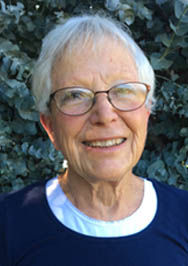It’s a cool, foggy morning and weeds are loving the fact that an extra cup of coffee will give them more time to climb.
Today is deadline day with a promise that my next column would be a continuation of the story of the Healdsburg Farmers Market and “The Market Bell.”
In the early years of the market, we were so close to the customers and they arrived so early that those of us not particularly adept at multi-tasking were challenged in setting up our display tables.
Tom Petersen, our first manager and founder, obtained a really pretty rope, (not one that had tied a gate or a horse outside for years) setting up a sort of barrier, like one at a theatre box office.
I can still picture Bess Cunningham and Claire Gildea, both never missed a market, patiently standing behind the rope, market baskets in hand and smiles on their faces. When nine o’clock arrived, the rope was removed and about 50 market customers would meander throughout our little market, finding Joe Sales’ freshly packed peaches, some from the ground in his orchard which had next-day bruises but if you worked with them right away they were delicious; Kazumi Nishio’s bouquets of blue, pink, white, yellow statice; white sweet corn that I thought was the strangest corn I had ever seen because corn was always yellow, wasn’t it?
And so, the line got longer and the availability of the prune drying plant on Haydon Street was terminated. We moved a number of times with a number of managers. Dr. Ritz loaned us the small parking lot behind what is now Mane Attraction but we outgrew that confinement quickly and moved to the empty block where the Swenson Building now stands on Healdsburg Avenue.
Dorothy Fineren took us all the way to 1990 and by then we were in the parking lot where we are today. That’s where we grew beautifully, thanks to the support of the community and the city hall. In those days we paid our city $100 for our annual permit to reside on the parking lot. We had electricity from one of the light poles and the support of the city to reserve two aisles exclusively for our market. There was a dirt lot behind what is now the Healdsburg Hotel and we used that space for the pumpkin and zucchini festivals.
Dorothy, with the help of Wayne and Lee James, organized the most wonderful market birthday celebrations. Lee would bring a couple of her Shetland sheep to market and would contact her wool spinning friends who would dress in costume like “Little House on the Prairie.“ Lee would show customers how to turn wool into felt and wear a soft, gray wool hat, knitted from her Shetland yarn. A huge birthday cake would be baked for all, with coffee and lemonade.
In August, when zucchini monsters hid beneath their leaves, Wayne James would travel to Sonoma Valley to pick up the zucchini track from Hilda Swartz, manager of Sonoma market. She was the county’s creator of the concept of the track and the racing zucchini, borrowed from a fair that she had attended in Kansas.
Wayne drove that road for years, obtaining the track and then having to load it back onto his truck for the return ride. He received a “thank you” but that was all.
(We didn’t realize how cumbersome the transporting of the track was until we had our own track. Wayne did it all without complaint.)
In 1990 Dorothy announced she did not want to manage the market because of “paper work the agriculture department and state” will be placing on farm market managers. I was asked if I would take the job and actually have a salary. (Prior managers merely had their stall fee waived.)
I absolutely loved that job for the next 14 years. There was only one thing I didn’t like. It was the voice of the vender that had been yelling at the top of her voice, “Market’s open.” Often she would wait until she was ready to sell, ignoring the actual time.
For our first market I went to John Wright’s Feed Store and purchased a genuine Swiss Cow Bell to replace the hollering woman. From that day onward, the bell opened market and venders from other markets expressed gratitude for adequate time to set up their stalls.
Next column: memories from 1990 to 2014.
Renee Kiff weeds and writes at her family farm in Alexander Valley.








